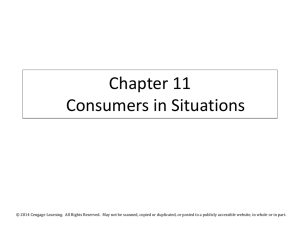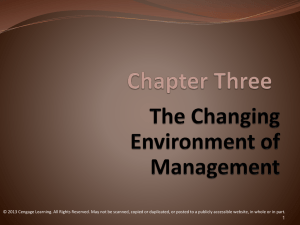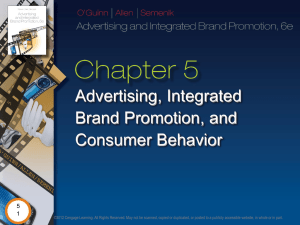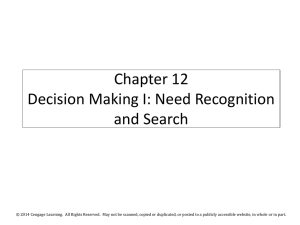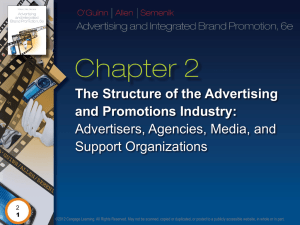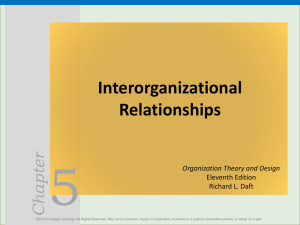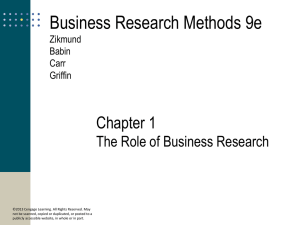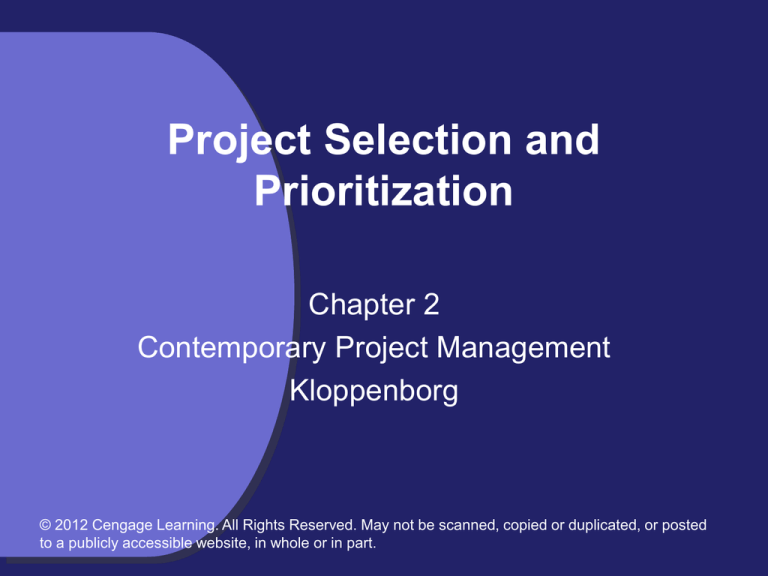
Project Selection and
Prioritization
Chapter 2
Contemporary Project Management
Kloppenborg
© 2012 Cengage Learning. All Rights Reserved. May not be scanned, copied or duplicated, or posted
to a publicly accessible website, in whole or in part.
Chapter
Vignette
D. D. Williamson, Louisville, KY
• How does a truly global company with fewer
than 200 associates achieve noteworthy results
and market leadership?
• Founded in 1865 D. D. Williamson is a global
leader in non-artificial colors
• 2004: Company embarked on a new vision to
double growth and profitability in five years.
• Identified the need to improve project
management as a key strategy to achieve the
vision.
© 2012 Cengage Learning. All Rights Reserved. May not be scanned, copied or duplicated, or posted
to a publicly accessible website, in whole or in part.
Chapter
Vignette
D. D. Williamson, Louisville, KY
• A prioritization matrix of 16 “critical projects”
would have senior leadership sponsors and be
assigned trained and capable project managers
to improve execution
• 2009: Changes to prioritization process selected
no more than five “Visual Impact Projects” (VIPs)
to receive high-level focus and attention
• Results: Large and complicated projects are
hitting the strategic target of “on time, on budget
and on target” regularly
© 2012 Cengage Learning. All Rights Reserved. May not be scanned, copied or duplicated, or posted
to a publicly accessible website, in whole or in part.
At the end of this chapter…
• Describe the strategic planning process.
• Describe the portfolio alignment process.
• Itemize strengths and weaknesses of using
financial and scoring models to select projects.
• Describe how to select and prioritize projects as
an outgrowth of strategic planning.
• Given organizational priorities and several
projects, demonstrate how to select and
prioritize projects using a scoring model.
• Describe how to secure projects.
© 2012 Cengage Learning. All Rights Reserved. May not be scanned, copied or duplicated, or posted
to a publicly accessible website, in whole or in part.
Strategic Planning Process
• Strategic Analysis
• Guiding Principles
– Vision
– Mission Statement
• Strategic Objectives
• Flow-down Objectives
© 2012 Cengage Learning. All Rights Reserved. May not be scanned, copied or duplicated, or posted
to a publicly accessible website, in whole or in part.
Strategic Planning and Portfolio
Alignment
© 2012 Cengage Learning. All Rights Reserved. May not be scanned, copied or duplicated, or posted
to a publicly accessible website, in whole or in part.
Strategic Analysis
• Analysis of internal and external environments
• SWOT Analysis (Strengths, Weaknesses,
Opportunities, and Threats)
• Elements within the project team’s control
– What strengths and weaknesses the organization
possesses in itself
• Elements over which the project team has
little/no control
– What opportunities and threats are posed by
competitors, suppliers, customers, regulatory
agencies, technologies
© 2012 Cengage Learning. All Rights Reserved. May not be scanned, copied or duplicated, or posted
to a publicly accessible website, in whole or in part.
SWOT Analysis for the Built Green
Home at Suncadia
Strengths
Weaknesses
Opportunities
Threats
Green building has a
buzz
Green building has not
reached mainstream
Uniqueness of product
Existing thinking on
green building and its
niche focus
Seattle has a strong
green building
community support
Limited project
resources community
Location
Building schedule
Strong community
support
Distance away from
Seattle Green building
is perceived to be
costly
Community
surrounding house
Community (location)
Growth in green
building projects that
demonstrate value
High cost of green
projects
Lack of data on green
building (wealth) value
Rumors
Need to provide
numbers on green
building value
© 2012 Cengage Learning. All Rights Reserved. May not be scanned, copied or duplicated, or posted
Committed
developer
to a publicly
accessible website, in whole or in part.
and builder
Guiding Principles
• The vision describes the organization of the
future
– “vivid description of a preferred future”
– Require extra effort to be achieved
– Often multiyear goals that end in suggesting the need
for a new vision
• The mission statement provides a mechanism
for achieving the vision
– “organization’s core purpose, core values”, beliefs,
culture, primary business, primary customers
© 2012 Cengage Learning. All Rights Reserved. May not be scanned, copied or duplicated, or posted
to a publicly accessible website, in whole or in part.
Mission Statement Considerations
• Purpose – communicates why an organization
exists
• Beliefs – what the leaders of an organization
stand for
• Core values – how decisions will be made and
how people will be treated
• Culture – how members should act
• Primary business areas – what business the
organization engages in
• Primary customers – which groups of people
need to be satisfied
© 2012 Cengage Learning. All Rights Reserved. May not be scanned, copied or duplicated, or posted
to a publicly accessible website, in whole or in part.
Cincinnati Children’s Hospital Medical
Center Vision and Mission
Vision
© 2012 Cengage Learning. All Rights Reserved. May not be scanned, copied or duplicated, or posted
to a publicly accessible website, in whole or in part.
Strategic Objectives
•
•
•
•
•
Means of achieving the vision and mission
Objective setting occurs annually
Describe short term and long term results
Describe measures of achievement
Effective objectives are SMART
–
–
–
–
–
Specific
Measurable
Achievable
Results-based
Time-specific
© 2012 Cengage Learning. All Rights Reserved. May not be scanned, copied or duplicated, or posted
to a publicly accessible website, in whole or in part.
Midland Insurance Company Strategic
Objectives
© 2012 Cengage Learning. All Rights Reserved. May not be scanned, copied or duplicated, or posted
to a publicly accessible website, in whole or in part.
Flow-down Objectives
• How to implement strategic objectives
• Objectives may be implemented through
ongoing operations
• Projects are the primary method for
implementing objectives
© 2012 Cengage Learning. All Rights Reserved. May not be scanned, copied or duplicated, or posted
to a publicly accessible website, in whole or in part.
Portfolio Alignment
•
•
•
•
Assess organization’s ability to perform projects
Portfolios
Programs
Projects and subprojects
© 2012 Cengage Learning. All Rights Reserved. May not be scanned, copied or duplicated, or posted
to a publicly accessible website, in whole or in part.
Portfolios
• Organizations require work activities including
ongoing operational work and temporary project
work
• Try to achieve a sense of balance in portfolios
– Some large and some small projects
– Some high-risk, high-reward projects and some lowrisk projects
– Some projects that can be completed quickly and
some that take substantial time
portfolio – “a collection of projects or programs and other
work that are grouped together to facilitate effective
management of that work to meet strategic business
objectives. The projects or programs of the portfolio may not
© 2012 Cengage Learning. All Rights Reserved. May not be scanned, copied or duplicated, or posted
be
interdependent
tonecessarily
a publicly accessible
website,
in whole or in part. or directly related.” PMBOK®
Programs
• Programs last as long as the organization lasts
• Specific projects within a program are of limited
duration
• Portfolios and programs are managed at a level
above the typical project manager
program – “a group of related projects managed in a
coordinated way to obtain benefits and control not
available from managing them individually. Programs may
include elements of work outside of the scope of discrete
projects in the program.” PMBOK® Guide
© 2012 Cengage Learning. All Rights Reserved. May not be scanned, copied or duplicated, or posted
to a publicly accessible website, in whole or in part.
Projects and Subprojects
• A large project may be composed of multiple
subprojects
• The project manager coordinates subprojects
and make decisions that are best for the overall
project
subproject – “a smaller portion of the overall project
created when a project is subdivided into more
manageable components or pieces.” PMBOK® Guide
© 2012 Cengage Learning. All Rights Reserved. May not be scanned, copied or duplicated, or posted
to a publicly accessible website, in whole or in part.
Portfolio of Projects and
Operational Work Processes
Reasons for Project Failure
•
•
•
•
•
Not enough resources
Not enough time
Unclear expectations
Changes to the project
Disagreement about expectations
© 2012 Cengage Learning. All Rights Reserved. May not be scanned, copied or duplicated, or posted
to a publicly accessible website, in whole or in part.
Project Alignment
• Aligned projects contribute to the organization’s
objectives
• Align potential projects with the goals of the
parent organization
© 2012 Cengage Learning. All Rights Reserved. May not be scanned, copied or duplicated, or posted
to a publicly accessible website, in whole or in part.
The Project Portfolio
• A collection of projects grouped to be collectively
managed
• Projects are selected to contribute to the
organization’s goals
• Portfolio alignment identifies, selects, and
prioritizes projects to help achieve an
organization’s strategic goals
© 2012 Cengage Learning. All Rights Reserved. May not be scanned, copied or duplicated, or posted
to a publicly accessible website, in whole or in part.
Portfolio, Program, Project, and
Subproject Relationships
© 2012 Cengage Learning. All Rights Reserved. May not be scanned, copied or duplicated, or posted
to a publicly accessible website, in whole or in part.
Assess Organization’s Ability to
Perform Projects
• Do we have a teamwork attitude, free and open
communication, creativity, and empowered
decision-making?
• Do we have a clearly defined project
management process?
• Do our associates have the right attitudes, skills,
and competencies to use the project
management process?
• Are our leaders at each level willing to take
appropriate personal risk?
© 2012 Cengage Learning. All Rights Reserved. May not be scanned, copied or duplicated, or posted
to a publicly accessible website, in whole or in part.
Assess Organization’s Ability to
Perform Projects
• Does senior leadership establish a strong
leadership foundation?
• Do individuals and teams exhibit leadership at
their respective levels?
• Do we monitor and understand our external
environment?
© 2012 Cengage Learning. All Rights Reserved. May not be scanned, copied or duplicated, or posted
to a publicly accessible website, in whole or in part.
Identifying Potential Projects
• People from all levels and all functional areas
should participate
• Identify twice as many potential projects as the
organization has time and resources to perform
• Develop a brief description of all potential
projects
– The “elevator speech”
statement of work – “narrative description of products or
services to be provided by the project.” PMBOK® Guide
business case – “provides the information needed from
a business standpoint to determine if the project is worth
© 2012the
Cengage
Learning. All Rights
Reserved. May not
be scanned, copied or duplicated, or posted
investment.”
PMBOK®
Guide
to a publicly accessible website, in whole or in part.
Project Selection, Prioritization, and
Initiation
© 2012 Cengage Learning. All Rights Reserved. May not be scanned, copied or duplicated, or posted
to a publicly accessible website, in whole or in part.
Methods for Selecting Projects
• Ensure overall organizational priorities are
understood, agreed upon, and communicated
• Prioritization considerations include:
– What value each potential project brings to the
organization?
– Are the demands of performing each project
understood?
– Are the resources needed to perform the project
available?
– Is there enthusiastic support both from external
customers and from one or more internal champions?
– Which projects will best help the organization achieve
its goals?
© 2012 Cengage Learning. All Rights Reserved. May not be scanned, copied or duplicated, or posted
to a publicly accessible website, in whole or in part.
Methods for Selecting Projects
• Include financial and scoring models
– Projects are investments
• Three different approaches
– Use financial analysis as the primary means of
determining which projects are selected
– Use financial models as screening devices to qualify
projects for a scoring model
– Financial justification is one factor in a multi-factor
scoring model
© 2012 Cengage Learning. All Rights Reserved. May not be scanned, copied or duplicated, or posted
to a publicly accessible website, in whole or in part.
Using a Financial Model to Select
Projects
• Compare expected project costs to expected
project benefits
• Net present value is the most widely accepted
model
– Discount the expected future value of project costs
and benefits
– Subtract the stream of discounted project costs from
the stream of discounted project benefits
– Result yields the net present value of the potential
project
© 2012 Cengage Learning. All Rights Reserved. May not be scanned, copied or duplicated, or posted
to a publicly accessible website, in whole or in part.
Using a Financial Model to Select
Projects
• The benefit-cost ratio model
– Divide the cash flow by the initial cash outlay
– A ratio above 1.0 means the project is expected to
profit
• The internal rate of return model
– Calculate the percentage return expected on the
project investment
– A ratio above the current cost of capital is considered
positive
© 2012 Cengage Learning. All Rights Reserved. May not be scanned, copied or duplicated, or posted
to a publicly accessible website, in whole or in part.
Using a Financial Model to Select
Projects
• The payback period
– Calculate how many years would be required to pay
back the initial project investment
– Shorter payback periods are desirable
• Financial models ensure that projects make
sense from a cost and return perspective
• None of the financial models ensure alignment
with an organization’s strategic goals
© 2012 Cengage Learning. All Rights Reserved. May not be scanned, copied or duplicated, or posted
to a publicly accessible website, in whole or in part.
Financial Models for Project
Selection
Benefit-Cost
Ratio
(BCR)
Cash
flow/Project
investment
Internal Rate of Payback Period
Return (IRR)
(PP)
Neutral Result NPV = $0
Ratio = 1.0
If used to
NPV >
screen
Acceptable
projects or to amount
select projects
outright
Ratio >
Acceptable
amount
IRR = Cost of
capital
IRR >
Acceptable
amount
Calculation
Net Present
Value
(NPV)
PV revenue –
PV cost
Percentage
Project costs/
return on project Annual cash flows
investment
Payback period =
Accepted length
Payback period <
Acceptable length
© 2012 Cengage Learning. All Rights Reserved. May not be scanned, copied or duplicated, or posted
to a publicly accessible website, in whole or in part.
Using a Scoring Model to Select
Projects
• Develop a list of project selection criteria
– How well does this project fit with at least one
organizational objective?
– How many customers are there for the expected
results?
– How competitively can the company price the project
results?
– What unique advantages will this project provide?
– Does the company have the resources needed?
– What is the probability of success?
– What is the expected return on investment?
© 2012 Cengage Learning. All Rights Reserved. May not be scanned, copied or duplicated, or posted
to a publicly accessible website, in whole or in part.
Using a Scoring Model to Select
Projects
• Identifying Potential Criteria
– Jointly determine what criteria will be used to select
projects
• Determine mandatory criteria
– Are there any situations that dictate a project must be
chosen regardless of any other consideration?
• Weighting criteria
– Give the most important criterion a weight of 10
– Assign other weights based on its importance relative
to the most important criterion
© 2012 Cengage Learning. All Rights Reserved. May not be scanned, copied or duplicated, or posted
to a publicly accessible website, in whole or in part.
Project Selection and Prioritization
Matrix
© 2012 Cengage Learning. All Rights Reserved. May not be scanned, copied or duplicated, or posted
to a publicly accessible website, in whole or in part.
Evaluating Projects Based on
Criteria
• Evaluate one criterion at a time
• Rate each project on that particular criterion
• Multiply the rating by the weight assigned to the
criteria
• Display as the weighted score in the main body
of each cell.
• Select the highest scoring projects
© 2012 Cengage Learning. All Rights Reserved. May not be scanned, copied or duplicated, or posted
to a publicly accessible website, in whole or in part.
Completed Project Selection and
Prioritization Matrix
© 2012 Cengage Learning. All Rights Reserved. May not be scanned, copied or duplicated, or posted
to a publicly accessible website, in whole or in part.
Sensitivity Analysis
• Examine what would happen to the decision if
factors going into it were to change
• Some criteria may be deemed more important
than others
• Add missing criteria or new alternatives
© 2012 Cengage Learning. All Rights Reserved. May not be scanned, copied or duplicated, or posted
to a publicly accessible website, in whole or in part.
Prioritizing Projects
• Determine which projects should be assigned
resources and be scheduled to begin first
• Scoring models provide input to the process
• Other considerations:
– The urgency of each project
– The cost of delaying the expected benefits from
various projects
– Practical details concerning the timing
© 2012 Cengage Learning. All Rights Reserved. May not be scanned, copied or duplicated, or posted
to a publicly accessible website, in whole or in part.
Alternative Breaks Project Selection
and Prioritization Matrix
Project/Selection Criteria
Active
Service
Organization
Opportunity Issue Itself to work with
9
New York Vegan Farm
5
10
4
45
West Virginia Sustainability
4
40
36
Chicago Halfway House
2
1
115
25
4
24
5
50
20
24
40
102
20
1
30
Total
123
5
4
5
9
4
4
4
5
18
30
18
El Salvador Cultural
Immersion
6
3
3
Cost
94
5
© 2012 Cengage Learning. All Rights Reserved. May not be scanned, copied or duplicated, or posted
to a publicly accessible website, in whole or in part.
Securing Projects – the Client
perspective
• Perform work processes necessary to secure
external resources for executing project work
–
–
–
–
Plan purchasing and acquisitions
Plan contracting
Request seller responses
Select sellers
© 2012 Cengage Learning. All Rights Reserved. May not be scanned, copied or duplicated, or posted
to a publicly accessible website, in whole or in part.
Securing Projects – the Contractor
perspective
•
•
•
•
Identify potential project opportunities
Determine which opportunities to pursue
Prepare and submit project proposal
Negotiate to secure the project
© 2012 Cengage Learning. All Rights Reserved. May not be scanned, copied or duplicated, or posted
to a publicly accessible website, in whole or in part.
Identify Potential Project Opportunities
• Perform portfolio alignment exercise
• Have representatives attend trade shows and
professional conferences
• Practice customer relationship management
– Establish and nurture personal contacts
– Link information systems to identify potential future
projects and improve management of current projects
© 2012 Cengage Learning. All Rights Reserved. May not be scanned, copied or duplicated, or posted
to a publicly accessible website, in whole or in part.
Determine Which Opportunities to Pursue
• Target projects to pursue
• Consider SWOT analysis to decide whether to
pursue a potential project
• Determine if a potential project will help achieve
contractor objectives
• Consider cost to pursue the work
• Consider probability of successfully securing the
project
• Consider the capability to perform the work
© 2012 Cengage Learning. All Rights Reserved. May not be scanned, copied or duplicated, or posted
to a publicly accessible website, in whole or in part.
Prepare and Submit Project Proposal
• Understand the criteria the client will use to
decide to whom they will award the project
• Consider technical, managerial, and financial
factors in contractor selection
© 2012 Cengage Learning. All Rights Reserved. May not be scanned, copied or duplicated, or posted
to a publicly accessible website, in whole or in part.
Typical Source Selection Criteria
Technical
Management
Financial
Operational
Technical
experience
Management
experience
Financial
capacity
Production
capacity
Needs
understanding
Project charter
Life cycle cost
Business size
and type
Technical
approach
Planning and
scheduling
Cost basis and
assumptions
Past
performance
Risk mitigation
Project control
Warranties
References
Negotiate to Secure the Project
• Negotiate the amount of money to be paid for
a project
• Negotiate contractual terms, schedule,
specific personnel, quality standards,
reporting mechanisms
• A project manager attempts to find a solution
to secure project work with enough profit
potential
© 2012 Cengage Learning. All Rights Reserved. May not be scanned, copied or duplicated, or posted
to a publicly accessible website, in whole or in part.
Summary
• Project selection begins with the organization’s
strategic planning
• Use SWOT analysis for strategic analysis of the
organization
• Develop mission and vision statements as
guiding principles
• Use portfolio alignment to consider resources,
organizational and individual capabilities
necessary for identifying project opportunities
© 2012 Cengage Learning. All Rights Reserved. May not be scanned, copied or duplicated, or posted
to a publicly accessible website, in whole or in part.
Summary
• Evaluate potential projects through financial
and/or scoring models
• Prioritize selected projects for completion
• Some external projects may be a better fit for
helping an organization reach its goals
© 2012 Cengage Learning. All Rights Reserved. May not be scanned, copied or duplicated, or posted
to a publicly accessible website, in whole or in part.
Prioritizing Projects at D. D.
Williamson
• Senior management team selected a maximum
of two projects per senior management sponsor
• Hired a continuous improvement manager as
project office and key resource for project
facilitation
• Elevated a subset of projects to highest status –
VIPs (Vision Impact Projects)
PM in Action Example
© 2012 Cengage Learning. All Rights Reserved. May not be scanned, copied or duplicated, or posted
to a publicly accessible website, in whole or in part.
Prioritizing Projects at D. D.
Williamson
• Global Operating Team now has laser focus on
five VIPs
• The prioritization process has become a
foundation of cross-functional success
PM in Action Example
© 2012 Cengage Learning. All Rights Reserved. May not be scanned, copied or duplicated, or posted
to a publicly accessible website, in whole or in part.


